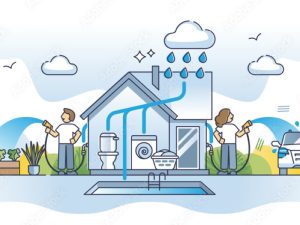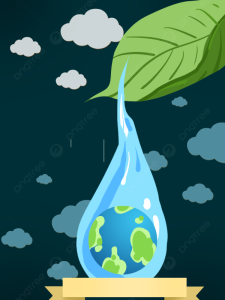The climate change phenomenon seems omnipresent with its impacts being felt around us in various ways. However, in a vast, tropical, and developing country like India, one of the areas that is more acutely felt, is the area of ‘water’ – the medium through which we feel the painful effects of climate change.
With our gargantuan population and an increasing ‘thirst’ for water across cities, industries, and agricultural communities, India has a pronounced vulnerability to climate change – simply because its agriculture system feeds 17.5% of the global population, all the while harnessing just 2.4 % of land and only 4% of the water on the planet. It is a delicate and fragile balancing act for our humble farmers, 90% of whom are small and marginal landholders.
Never before has water conservation been so vital, with conservation techniques being the fundamental difference between a ‘water starved community’ that relies on expensive and erratic water tanker delivery, or between a ‘water prosperous community’ which is self-sufficient in terms of water, with all year around access to this precious, life and livelihood giving, resource.
This intimate relationship between climate change and water means that investing in water conservation techniques is a crucial part of fostering climate change resilience – particularly among vulnerable rural populations – people, communities, and an agricultural industry that these communities are built upon, and that feeds the nation.
 Photo Courtesy: Shutterstock
Photo Courtesy: Shutterstock
Snapshot from ‘the Ground’
What does this climate change-induced ‘water stress’ look like on the ground in rural India?
-
An increased frequency of drought means that less water is available, and the subsequent rises in temperature only increase a farmer’s demand of water for crops.
-
High-intensity rainfall increases soil erosion and results in high water runoff – runoff that takes with it precious topsoil that silts up water harvesting structures, reducing their ultimate water storage capacity.
-
Short duration, high-intensity rainfall which is exacerbated by climate change, also results in low groundwater recharge – reducing the availability of groundwater for usage.
-
Irregular rainfall distribution and long intermediate dry spells during monsoon severely impact crop yield in rainfed areas.
However, across the country, there are many leading examples of how water conservation – coordinated efforts to increase the supply of water, as well as reducing the demand for it – has changed the water narrative in villages. Whilst it is easy to shrug off the responsibility of water conservation methods to Governments to lead the charge, there is, in fact, a role to be played by everyone – villagers, communities, people’s institutions, corporates, and civil society – in the uptake of various water conservation measures to generate ‘water resilient communities in rural India.
But it requires a two-pronged approach.
-
Increasing Water Supply
Water resilience can be fostered, by increasing the supply of it for drinking, sanitation, and irrigation purposes – working with households, farmers, and communities to develop mechanisms to simply capture rainwater as and when it falls enabling percolation and recharge– storing it for use in the ‘dry months’ India is renowned for.

Photo Courtesy: Adobe Stock
At a household level, investment in a rooftop rainwater harvesting system (RRWHS) is proven as one of the cost-effective ways to increase safe drinking water supply.,. Self-sufficient households in terms of water, are not only better equipped to survive severe climate variability and drought, but are empowered with a responsibility to both capture and efficiently manage the use of their own water. An RRWHS constructed with a 12,000-liter capacity can be sufficient to meet the drinking and cooking water needs for a family of 5-6 members, for at least 250 days in a year – meaning a family’s needs are met for the rest of the year, post monsoon. This is a game-changer for families living in remote and water-stressed -communities as the quality of water is also assured.
Additionally, the revival and restoration of traditional water harvesting structures which are scattered across the country, is another priority in order to increase water supply. Whilst most of these have fallen into disrepair, these unique structures have helped generations of Indians for millennia, to survive the harsh climatic conditions of remote India. Sadly, during the colonization of India, the British replaced the decentralized, communal responsibility of managing water, with a centralized one where the Public Works Department took control of water. As a result, people gave up the responsibility of managing and caring for water. But these incredible structures still exist and many simply lie in disuse, in need of restoration and repair – with work, they can be revived to their former glory.
With many communities facing issues with contamination of water supplies, like salinity and increased levels of fluoride due to over-extracted groundwater reserves, building the capacity of a community to test its own water and identify local solutions is yet another solution to making communities self-reliant when it comes to water.
-
Reducing Water Demand
However, an increase in water supply alone is not enough to generate self-sufficient, resilient communities when it comes to water. With the agricultural sector consuming 90 percent of all water drawn across the country as reported, primarily for flood-irrigating water-intensive crops, there is a drastic need to convert farmers to more water-efficient agricultural practices.
Flood irrigation currently delivers only 35-40 percent water use efficiency, as opposed to micro irrigation which has up to 90 percent efficiency. Despite this, the coverage of drip (2.13 percent) and sprinkler (3.30 percent) methods of irrigation is meager compared to its total potential in India. This presents an exciting opportunity for widescale investment in micro irrigation as a key approach to reducing the demand for water. The slow spread of micro irrigation is not mainly due to economic reasons, but due to a lack of awareness among the farmers about the real economic and revenue-related benefits of it. In fact, by adopting micro-irrigation, farmers experience an increase in productivity – by being able to precisely control water application at the plant roots, crop yield is increased, resulting in an increase in profits. Additionally, farmers who adopt micro irrigation experience a reduced cost of cultivation – enhancing overall profits. It is a win-win on all fronts.

Photo Courtesy: Pngtree
Additionally, according to experts at the Central Water Commission, India’s cropping pattern highlights the rampant cultivation of water-intensive crops such as sugarcane, paddy, cotton, and banana, across water-stressed regions of India. As agriculture is the largest consumer of freshwater in India, the shift from water-intensive crops to less water-intensive crops such as pulses, millets, vegetables, legumes, and oilseeds, can spare large quantities of fresh water in India, with minimal cost, for the benefit of farmers. An investment in farmer education and capacity building is required here.
Conclusion
The evidence is clear. The climate is changing and will continue to do so, affecting all communities, primarily through the resource of water. Climate change will affect the availability, quality, and quantity of water for basic human needs and livelihoods, threatening the fundamental human rights to water of potentially billions of people. Strategic water conservation measures can be the key to creating climate-resilient rural communities, which have the means, in terms of water, to not just survive, but thrive & prosper, as they continue to grow food for the rest of the country.
Neerain is proud to republish this blog for spreading awareness about the situation of water, for our stakeholders. Credit whatsoever goes to the Author.
This blog is published by: –
We would like to spread this for the benefit of fellow Indians.
Author: Pearl Tiwari
Publish On: October 13, 2022
